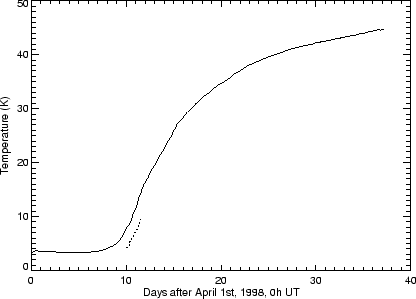The temperature of the focal plane steadily increased after the helium
boil-off. Figure 6.1 shows how after some days it
exceeded the dynamic range of the temperature sensors on the optical support
structure. The temperature trend of the focal plane further in the
Post-Helium
Phase can be inferred from a similar trend seen in the temperatures of
the upper baffle of the ISO telescope. It is estimated that the temperature of the SWS detectors increased from the nominal operating temperature
(1.8 ![]() 0.1 K) to 40 K
0.1 K) to 40 K ![]() 5 K over the 30 days of post-helium
operations.
5 K over the 30 days of post-helium
operations.

|
Before the helium boil-off, it was anticipated that the temperature of the focal plane would increase sufficiently to allow operating the JFET cryogenic readout without heating. The slow temperature increase however made heating required throughout the entire Post-Helium Phase for the JFETs to function properly. This was verified during every revolution with SWS operations. The instrument controllers manually uplinked a command sequence to the spacecraft to switch off the JFET-heaters for one minute. It was verified offline that this indeed corrupted the detector readout.